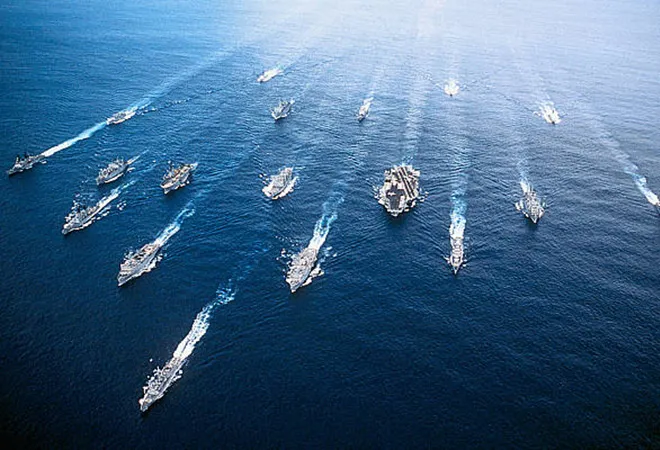 This piece is part of the series, Governance Propositions of 2022
This piece is part of the series, Governance Propositions of 2022
In recent times, the oceans have come to be increasingly seen as mental constructs that go beyond security into the realm of economy, politics, culture, and environment. The focus has been shifting from continents to oceans, as different oceanic spaces metamorphosed into new theatres of competition and power politics. Amongst various maritime theatres, the Indo-Pacific region has emerged as the key area of interest, attention, cooperation, and contestation.
2021 has been a watershed year for the Indo-Pacific region, with major policy, framework, and posture adaptations made by many countries and regional groupings, both within and outside the region. With clear recognition of the all-round importance of the region in the coming decades, the hardening of big power rivalry and competition, and the emergence of new approaches tailored for the post-pandemic world, many new formal and informal partnerships and arrangements were initiated. Major developments took place in the geostrategic space, based on respective interests and assessment of the current and emerging threats, challenges, and opportunities. Coercion as well as counter-coercion strategies, and military balance discussions became important again, consequent to the actions of some powers.
With clear recognition of the all-round importance of the region in the coming decades, the hardening of big power rivalry and competition, and the emergence of new approaches tailored for the post-pandemic world, many new formal and informal partnerships and arrangements were initiated.
The new Biden administration maintained the primary focus on China and the Eastern Indo-Pacific region, albeit with a different approach and an increased sense of urgency, as compared to the Trump administration. The maiden virtual summit of the Quad was held in March 2021, followed by
another in-person summit in September 2021, formalising the partnership between Australia, India, Japan, and the United States (US). A new semi-formal security alliance AUKUS, comprising Australia, the UK, and the US, was announced in September 2021. China increased its efforts to strengthen influence in the region, counter the American strategies and actions, maintain aggressive stance in ongoing disputes/tensions, and regain initiative in areas adversely affected by the pandemic. Russia indicated clear intent for a more proactive role in the region. The European Union (EU) outlined its maiden, very comprehensive strategy for the Indo-Pacific region in March 2021, and adopted the
final version through a joint communication in September last year. It highlighted the plan to deepen partnerships with countries/groupings that have enunciated Indo-Pacific strategies/outlooks of their own. The UK released its Integrated Review—“
Global Britain in a Competitive Age”—and its plan for a ‘tilt’ to the Indo-Pacific region in March 2021. Japan, India, and Australia stepped up initiatives in multiple domains, ASEAN stressed the importance of ASEAN-led mechanisms, and major realignments took place in West Asia, Afghanistan, and the Middle East. A ‘
West Asia Quad’ was also announced. To some extent, these developments were also facilitated by the growing appeal of minilateralism. The list of new initiatives and mechanisms in 2021, centered on the Indo-Pacific region, would be long and exhaustive. What stands out clearly is that notwithstanding repeated disruptions and challenges caused by the pandemic, the strategies, engagements, and programmes in this region moved at an unprecedented pace. The region was also at the centre stage during the summits of G20 and BRICS, and during the deliberations at COP26.
Japan, India, and Australia stepped up initiatives in multiple domains, ASEAN stressed the importance of ASEAN-led mechanisms, and major realignments took place in West Asia, Afghanistan, and the Middle East.
While the Indo-Pacific strategies of most countries evolved to become more comprehensive and well-rounded, the maritime domain continued to remain prominent. Many countries set up special departments or units to give impetus to their strategies for the region, with special emphasis on the maritime component. There was increased consensus to keep the maritime routes safe and open; accord priority to the blue economy, maritime infrastructure and connectivity; make global value chains resilient and leverage maritime partnerships for public good. In August 2021,
the UN Security Council unanimously adopted its first-ever statement on maritime security, under India’s presidency. The need for a framework of mutual understanding and cooperation in five key areas—trade, disputes, natural disasters, environment, and connectivity—was also stressed by India. The trend of gradual enhancement in the ambit of maritime security continued, with new emphasis on traditional as well as non-traditional threats. Bilateral and multilateral naval exercises increased in numbers and scope; and information-sharing, maritime domain awareness (including underwater), capacity building, and capability development remained key themes in cooperative initiatives. The need for compliance with International Maritime Law, particularly the UNCLOS, was stressed by many countries. Despite numerous partnerships and specific steps taken, the overall maritime environment remained challenging and uncertain, particularly in the East China Sea, South China Sea, and the Bab-el-Mandeb Strait.
The developments in the Indo-Pacific region in 2021 were dominated by a combination of geostrategic and geo-economic interests. The importance of ocean governance in the security, economic, development, environmental, resource resilience, and ecological domains, with specific reference to the Indo-Pacific, was stressed at various fora, given that some states have continued to push for increasing their spheres of influence in and around the oceans. The EU’s Indo-Pacific strategy outlined ocean governance as one of the seven priority areas
. India’s Indo-Pacific Oceans Initiative, with its seven pillars, gained resonance and support from some key players, including Australia, Japan, France, Vietnam, and the Philippines. The emphasis was on using existing institutions and frameworks for strengthening ocean governance, instead of creating new ones. At the same time, there is recognition that extant frameworks and institutions have shown limitations in taking the ocean governance agenda forward. The Indian Ocean Commission has attempted to put out a comprehensive framework for oceanic and maritime issues, though its initiatives have been broadly confined to the western Indian Ocean. Similarly, other institutions and frameworks have sought to incrementally address the challenges of ocean governance, which remains in a state of flux.
The EU’s Indo-Pacific strategy outlined ocean governance as one of the seven priority areas. India’s Indo-Pacific Oceans Initiative, with its seven pillars, gained resonance and support from some key players, including Australia, Japan, France, Vietnam, and the Philippines.
There is increased understanding that sea and ocean governance is very different from governance of maritime and coastal spaces—which are under the sovereign jurisdiction of national governments—and would thus require innovative structures and visionary leadership. The new framework for ocean governance needs to be based on mutual understanding and cooperation, with common interpretation of the relevant laws and norms. There is need to establish such a framework for the Indo-Pacific, with the primary task of building consensus and improving coordination between multiple bodies and institutions. In case current sub-regional institutions and frameworks are to be considered the mainstay to strengthen ocean governance, a suitable mechanism for interaction and interface between them would still be needed.
The trends of 2021 in the Indo-Pacific are likely to continue in the coming year, with the overall environment staying tense and uncertain. Increased maritime orientation would be sustained, though for some countries it will be suitable hybridisation of continental and maritime strategies. New security and economic partnerships are likely to emerge, and new initiatives under the existing alliances and partnerships may be announced. The security partnership between competing parties may get accelerated, with appropriate signaling. The extension of competition to all domains, including ideological, technological, social, and even sports, would exacerbate friction. The implementation of the Indo-Pacific strategies of different players will get tested for delivery and effectiveness. As seen in the recent past, shocks due to unexpected developments and actions may continue to cause disruptions. Against this backdrop, it will require a special effort to accord the much-needed priority to ocean governance. A new thrust on ocean governance, with appropriate and inclusive framework for cooperation, can itself be a major contributor to enhancing stability, safety, security, development, and well-being in the region and beyond.
The views expressed above belong to the author(s). ORF research and analyses now available on Telegram! Click here to access our curated content — blogs, longforms and interviews.



 This piece is part of the series,
This piece is part of the series,  PREV
PREV


